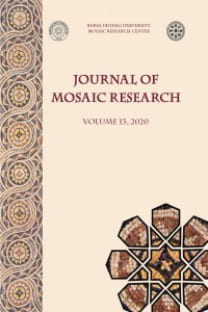Roma Mozaiklerinde Ulysses ve Polyphemus’un Temsili. Analizler ve Karşılaştırmalar
Mozaikler, Ulysses, Polyphemus, Kikloplar, Metis
The Representation of Ulysses and Polyphemus in Roman Mosaics. Analyses and Comparisons
Mosaics, Ulysses, Polyphemus, Cyclops, Metis,
___
- Albersheimer 2009 S. Albersheimer (ed.), Heroes. Mortals and Myths in Ancient Greece, Baltimore.
- Alvino 1996 G. Alvino, “Il IX libro dell’Odissea : l’offerta della coppa di vino. Il gruppo fittile di Colle Cesarano e il gruppo scultoreo di Efeso”, B. Andreae - C. Parisi Presicce (eds.), Ulisse. Il mito e la memoria, Rome, 201-209.
- Alvino - Gatti 1988 G. Alvino - S. Gatti, “Indagini archeologiche lungo la Fiano-San Cesareo. Un esempio di tutela preventiva nella realizzazzione delle grandi opere pubbliche”, Autostrade, 89-95.
- Andreae - Presicce 1996 B. Andreae - C. P. Presicce (eds.), Ulisse. Il mito e la memoria, Rome.
- Arias - Hirmer 1962 P. E. Arias - M. Hirmer, A History of Greek Vase Painting, Londres.
- Balil 1969 A. Balil, “Dos mosaicos hispanicos de tema mitológicos”, X congreso nacional de arqueologia (Mahon 1967), Zaragoza, 379-386.
- Balland 1967 A. Balland, “Une transposition de la grotte de Tibère à Sperlonga : le Ninfeo Bergantino de Castelgandolfo”, Mélanges d‘archéologie et d‘histoire 79, 2, 421-502.
- Beccatti 1970 G. Beccatti, Mosaici antichi in Italia, Regione settima. Baccano, villa romana, Rome.
- Bragantini - Sampaolo 2009 I. Bragantini - V. Sampaolo (a cura di), La pittura pompeiana, Napoli.
- Bussière - Lindros Wohl 2017 J. Bussière - B. Lindros Whol, Ancient Lamps in the J. Paul Getty Museum, Los Angeles.
- Carandini et al. 1982 A. Carandini - M. De Vos - A. Ricci, Filosofiana. La villa di Piazza Armerina. Immagine di un aristocratico romano al tempo di Constantino, Palermo.
- Chantraine 2009 P. Chantraine, Dictionnaire étymologique de la langue grecque, Paris.
- Courbin 1955 P. Courbin, “Un fragment de cratère protoargien”, BCH 79, 1-49.
- Darmon 2004 J.-P. Darmon, “Joueurs de dés et autres énigmes de la mosaïque aux chevaux de Carthage”, BAntFr, Séance du 5 avril 2000, 106-118.
- Fabbricotti 1980 E. Fabbricotti, “Divagazioni su un Polifemo musivo di Tarragona e sue analogie con uno romano”, QuadChieti 2, 77-84.
- Frontisi - Ducroux -Vernant 1997 F. Frontisi-Ducroux - J.-P. Vernant, Dans l’oeil du miroir, Paris.
- Ginouvès 1993 R. Ginouvès (ed.), La Macédoine. De Philippe II à la conquête romaine, Paris.
- Guidobaldi - Esposito 2012 M. P. Guidobaldi - D. Esposito, Herculanum, Paris.
- Jones 1809 W. Jones, Asiatic Researches VIII, New Delhi.
- Jouanno 2013 C. Jouanno, Ulysse. Odyssée d’un personnage d’Homère à Joyce, Paris.
- Knox 1979 M. Knox, “Polyphemos and His Near-Eastern Relations”, JHS 99, 164-165.
- Lancha 1997 J. Lancha, Mosaïque et culture de l’Occident romain (Ier-IVe s.), Rome.
- Latacz et al. 2008 J. Latacz - T. Greub - P. Blome - A. Wieczorek (eds.), Homer. Der Mythos von Troia in Dichtung und Kunst, München.
- Lavagne 1970 H. Lavagne, “Le nymphée au Polyphème de la Domus Aurea”, Mélanges d‘archéologie et d‘histoire 82, 2, 673-721.
- Malkin 2018 I. Malkin, Un tout petit monde. Les réseaux grecs de l’Antiquité, Paris.
- Miele 2007 F. Miele, “Polifemo riceve una lettera da Galatea”, M. L. Nava, R. Paris, R. Friggeri (a cura di), Rosso Pompeiano. La decorazione pittorica nelle collezioni del Museo di Napoli e a Pompei, Milan.
- Minaud 2006 G. Minaud, “Des doigts pour le dire. Le comput digital et ses symboles dans l‘iconographie romaine”, Histoire & Mesure XXI/1, 3-34.
- Museo Nazionale Romano 2012 Museo Nazionale Romano Palazzo Massimo alle Terme / i mosaici, a cura di R. Paris, M.T. Di Sarcina, Milan.
- Pailler 1971 J.-M. Pailler, “Attis, Polyphème et le thiase bachique : quelques représentations méconnues”, MEFRA 83, 1, 127-139.
- ISSN: 1309-047X
- Başlangıç: 2008
- Yayıncı: Ululdağ Üniversitesi, Mozaik Araştırlmaları Merkezi
Kitap İncelemesi: Mosaicos romanos en el espacio rural: Investigación y puesta en valor
Braga’daki (Portekiz) D. Diogo de Sousa Arkeoloji Müzesi’ne Bağışlanan Üç Mozaik Üzerine Bir Çalışma
Maria De Fátima ABRAÇOS, Licínia WRENCH, Cátia MOURÃO
Kibyra Odeion’unun Mozaik Yazıtları
Elif ALTEN GÜLER, Düzgün TARKAN
Astigi’den (Baetica) Zeus’un Aşkları Konulu Roma Mozaiğinde Ganymedes’in Tasviri Üzerine
Ve Dionysos Dalgalardan Yükseldi… Kabul Salonlarının Mozaikleri Üzerindeki Dionysos ve Deniz
Suriye’nin Kuzeyinde in situ Yeni Osrhoene Mozaikleri
Komait ABDALLAH, Alain DESREUMAUX, Mohamad AL-KAİD
Erdem’den Güce: Kadın Kahramanlığı Hakkında Keşifler - Lilian Broca Mozaikleri
Roma Mozaiklerinde Ulysses ve Polyphemus’un Temsili. Analizler ve Karşılaştırmalar
Philippopolis, Trakya’daki, İS 6. yüzyıl Mozaik Döşemeleri. Bazı Düşünceler
